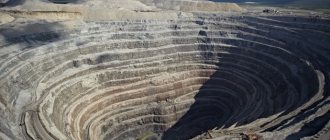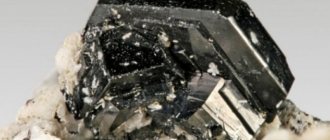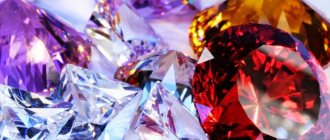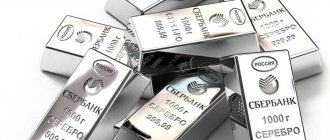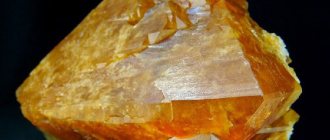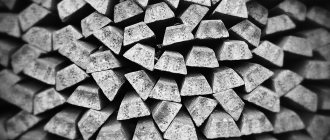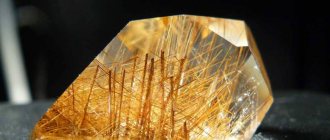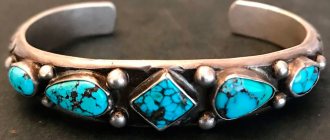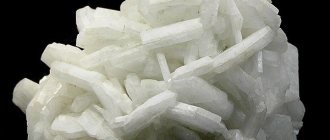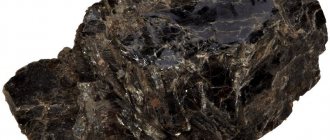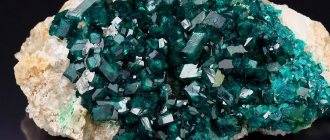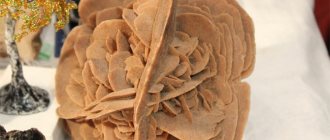Mica is a group of rocks and minerals that have a layered structure and are formed as a result of volcanic processes. Due to the fact that stone can exfoliate into thin layers, in the distant past it was used instead of glass.
Mica as a mineral has many varieties due to its variable chemical composition; it has a rich palette of colors and shades.
Today, mica is a valuable raw material in industry, agriculture and medicine; it is also widely used in jewelry, decoration and collecting.
Origin and history
Mica is a rock of metamorphic and volcanic origin. It is distinguished from other minerals and artificial analogues by its layered structure. Mica is present in many other minerals. Thus, granite is based on quartz, feldspar and mica. The pearlescent luster of precious stones also appears due to mica inclusions.
mica window
The use of this rock is traced in cave paintings from Paleolithic times. Mica layers were split into thin plates and used as window glass in Ancient Egypt, Greece and Rome, and China. In Teotihuacan, the city of Mexican gods, mica was used to decorate temples, pyramids, sculptures and statues.
In Russia, then called Muscovy, large-scale mining of muscovite was carried out. The charioteer of Peter I, the royal lamps, and window frames were made from this mineral. Mica was used in decorating icons and church regalia.
At the end of the 19th century, fluorphlogopite was created by a Russian chemist. This is an artificial analogue of phlogopite, which is superior in properties to the natural mineral, but visually has no differences. Artificial imitation can only be recognized in a laboratory setting.
What is mica
Mica is a common rock-forming mineral that is similar in appearance to ordinary glass. Any type of it forms the same type of crystal, which can have different color shades or be transparent.
There are several varieties of mica, each differing in the metal and impurities it contains. However, properties such as ease of separation into hard thin layers, elasticity, flexibility, and strength are present in any type of mineral. This breed is also distinguished by its soft structure, which is why, after pressing with a finger, dents remain on it.
Mica is of volcanic origin and lies in the bowels of the earth in those countries whose climatic conditions favor the formation of silicates. It can also be grown under artificial conditions, and the properties of mica will be the same as those of natural stones.
Physicochemical characteristics of mica
According to the chemical composition, mica stone is an aluminosilicate. The general formula for all varieties of the mineral looks like this:
X+Y23+[Si4O10](OH, F)2 or X+Y32+[AlSi3O10](OH, F)2, where
X is potassium or sodium, yttrium, ammonium;
Y is magnesium, iron, aluminum or barium, manganese, calcium, titanium, zinc boron, vanadium, uranium dioxide.
Mica - description of physical characteristics:
| Index | Description |
| Mohs hardness | 2.5-3 units |
| Density | Phlogopite – 2,200 kg/m³ Muscovite – 2,770 kg/m³ Biotite – 3,300 kg/m³ |
| Transparency | Absolutely transparent in thin plates and scales, translucent |
| Flexibility and resilience | High |
| Thermal resistance index | Phlogopite – up to 800°С Muscovite – up to 700°С |
| Melting temperature | 1140-1400°C depending on the chemical composition |
| Cleavage | Basal (very perfect) |
| Electrical insulating properties | The dielectric constant |
Stone mining methods
Mica occurs naturally in nature, but it can also be grown artificially.
If we talk about natural mining of the mineral, then 2 options are used, depending on the depth of its occurrence:
- Open. Suitable for stones located no deeper than 100 m. In this case, the quarry principle is used, when the top layer of the earth is drilled or exploded with dynamite, high-quality crystals are selected manually.
- Closed (mine). It is used in the extraction of mica at depths from 100 to 4000 m. Shafts and underground passages are laid to the location of the mineral, and the ground around the deposits is exploded or loosened with a drill.
In the process of producing synthetic stone, conditions are created that are as close as possible to natural ones: the temperature is kept within 1400 °C with a gradual decrease to 1200 °C, almost the same components are used as natural mica. The result is a fine crystal suitable for powder or small products.
Varieties
Mica is divided into varieties depending on the chemical composition and industrial use.
Biotite
In the first case, the following types of mica are distinguished:
- Magnesium-iron micas:
- Biotite is an opaque mineral with a predominance of iron in its composition and can be colored in brown shades, turning into green and black.
- Phlogopite is a transparent stone whose color varies from light yellow to brown.
- Lepidomelan is a black variety of biotite, whose chemical composition is iron oxide.
- Aluminum mica:
- Muscovite is the most common variety of mica. Muscovite plates are colorless and completely transparent and translucent. Depending on the impurities, a pink, yellow or green tint may appear.
- Paragonite is a rare variety of mica whose properties are similar to muscovite. One of the main differences is that in paragonite potassium is replaced by sodium, which is why it is called soda mica.
- Vanadium micas:
- Roscoelite is a rare variety of muscovite that contains vanadium instead of aluminum. Translucent gems with a pearlescent tint are colored olive, green, brown-green, red-brown and even black.
- Lithium mica:
- Lepidolite is a translucent mineral with a heterogeneous color and a lamellar structure formed in the form of buds. Lepidolites have a wide range of shades - they can be colored light grey, lilac, pink, lilac and pale yellow.
- Tainiolite is a transparent stone with a glassy luster that can be colorless or have brown tints.
- Zinnwaldite is a gray, silver, black or brown mineral with a pearlescent luster and transparent thin scales.
- Chrome micas:
- Fuchsite (chrome muscovite) is green muscovite, in which chromium replaces aluminum.
Depending on the industrial application, micas are:
- sheet mica (large-sized layers);
- intumescent mica (including vermiculite);
- scrap and fine crystals (residues from the production of sheet mica).
Magical powers
The magic of mica is determined by the variety or color of the mineral:
- Stones of yellow-brown shades are an attribute of careerists, financiers and those who want to get rich.
- Green muscovite is a regulator of internal harmony.
- Pink is the stone of love . Suitable for people looking for their soul mate or seeking to revive a former passion.
- White or grayish muscovites are worn in cold weather to avoid freezing.
However, only natural mica stone is suitable as a talisman or amulet.
Place of Birth
Rock fragment with mica
Deposits of the mineral are scattered throughout the planet, however, large crystals of high-quality sheet mica are rarely found in nature.
Large muscovite druses are mined in Brazil, India, the USA and Russia (Karelia, Murmansk and Irkutsk regions).
In Canada, the Malagasy Republic and Russia (Yakutia, Transbaikalia and the Kola Peninsula) phlogopite deposits are being developed.
Lepidolite deposits are concentrated in Kazakhstan, the USA, Namibia, Sweden, Moravia and Transbaikalia in Russia.
Large layers of biotite are mined in Norway, France, Canada, Tanzania, Germany and the Ural Mountains of Russia.
Form of being in nature
Crystal Appearance
tabular (pseudogexagonal), short-prismatic, sometimes truncated pyramidal. The crystals are often roughly formed with pronounced parallel shading on the lateral faces. In shape they are indistinguishable from biotite crystals.
Doubles
frequent. In general, mica twins can be formed according to various laws. Most often there are those in which the twin plane is a plane perpendicular to (001) and passing along the (110) : (001) edge. Typically, individuals grow together along planes perpendicular to (001), so that the planes of cleavage pass from one individual to another without interruption. This is the so-called mica law of twinning. According to the same law, tees are also formed (a third grows to two individuals). Often in such tees, individuals germinate each other. In them, they often have a feathery structure relative to twin sutures, due to the fact that rectilinear thin folds or roughly pronounced strokes are located perpendicular to the (110) : (001) edge. Another law is called the chlorite law; in this case, the twin plane is (001).
Aggregates
Dense, leafy-lamellar, scaly.
Areas of application
Industry
Various products made from electrical mica
Mica is in demand in many industrial sectors:
- Construction – ground mica is included in cement mixtures. Expanded vermiculite is the basis of thermal insulation materials.
- Chemical industry - mica is an integral component of some paint coatings, rubber and plastic products.
- Mechanical engineering - due to its electrical insulating properties, mica is used in instrument, aircraft and shipbuilding. The mineral is used as a raw material for the manufacture of electric heating devices, navigators, household appliances, as well as optical medical devices.
Agriculture
The mineral is used as a feed filler in livestock farming. In agriculture, farmers use powdered mica to mulch and fertilize the soil. Thanks to this, the soil structure improves and productivity increases several times.
Interior
Mica is used to create stained glass inserts into furniture elements, thus creating the atmosphere of past centuries. Original boxes are made from the mineral. Small crystals are used for wall cladding. Interior items made of ivory are coated with a mica composition to give the surface a pearlescent sheen.
Cosmetology
Mica is used as a raw material in the manufacture of cosmetics. It is added to creams, powders, shadows and lipsticks as pearl.
Ring with mica muscovite
Decorations
Mica is processed into a cabochon and inserted into jewelry - rings, earrings, pendants and brooches. Bracelets and beads are not made from stones, since in these products they are subject to increased mechanical stress.
Mica crystal in feldspar and quartz
Types of Mikanites
The sheets are glued together from plucked mica plates. Resins and varnishes on various bases are used as adhesives. Split mica leaves are laid out on the work surface in one layer, and glue is applied by spraying. Then new plates are laid on top, spraying them with adhesive until a sheet of the desired thickness is obtained. Next, the sheet material is hot pressed.
The micanite brand consists of 3-4 letters with the possible addition of numbers.
Explanation:
| Letters | |||
| First | Second | Third | Fourth |
| Type | A variety of mica | Binder | Reduced impregnation content |
| K – collector, P – spacer, F – molding, G – flexible | M – muscovite, F – phlogopite, C – mixture of M + F | G – glypthal, Ш – shellac, K – organosilicon, P – polyester, S – oil-glypthal; Ch – oil-bitumen | A |
Example: KFSh is a collector micanite made of phlogopite mica on a shellac binder. If there is a letter A at the end, this means a reduced content of the adhesive composition, the mass fraction of which is in the range from 5 to 12%.
Collector micanite
This is a sheet material with a base of plucked plates of ordinary and heat-resistant phlogopite on a shellac, glypthal or polyester binder. The sheets are produced by pressing when heated to 1550C. The material pressed under pressure up to 20 MPa is ground and a binder impregnation is applied again. The sheets are then pressed again to achieve a denser structure.
To prevent the mica plates from sliding, a small amount of adhesive is added to the collector micanites. The mass fraction of this component does not exceed 6%. The products are manufactured in thicknesses from 0.4 to 1.5 mm.
Types of insulation products and maximum permissible operating temperature:
| Type according to GOST 25045 | Composition of collector micanite | T max , 0С | ||
| Mica | Binder | |||
| 11 | F (phlogopite) | Ordinary | Ш (shellac) or G (glyphthalic) | 130 |
| 12 | P (polyester) | 155 | ||
| 13 | Heat resistant | Ammonium phosphate | >180 | |
| 14 | G (glyphthalic) | 130 | ||
The material is used for insulating lamellas of electrical machine collectors, including for special purposes.
Spacer micanite
The products are made from muscovite mica, regular/heat-resistant phlogopite or a mixture of two types on a glypthal/organosilicon binder.
Types and maximum permissible operating temperatures:
| Type | Composition of cushioning micanite | T max , 0С | |
| Mica | Binder | ||
| 21 | M (muscovite) or C (mixture) = M + F (common phlogopite) | Glyphthalic | 130 |
| 22 | F (heat-resistant phlogopite) | Organosilicon | 180 |
The mass fraction of the binder is in the range from 6 to 20%, mica - from 80 to 94%.
The material is used for the manufacture of washers and gaskets for electrical machines and units. Spacer micanite made from heat-resistant phlogopite with an organosilicon binder is also used for coil insulation of rotors and turbogenerators.
Molding micanite
Sheets with a thickness of 0.15-2 mm are produced from mica muscovite, ordinary/heat-resistant phlogopite on a polyester, organosilicon, glypthal binder with a normal or reduced content of adhesive composition. The sheet material is pressed with a pressure of up to 1 MPa once when heated to 1550C, so it has a less dense structure compared to the collector and spacer type.
Products of a given shape are made from blanks using the hot pressing method. Parts formed in a heated state retain their geometric parameters after cooling.
Types and maximum permissible operating temperature:
| Type | Composition of molding micanite | T max , 0С | ||
| Mica | Binder | |||
| 31 | F (phlogopite) | Ordinary | Glyphthalic | 130 |
| Heat resistant | ||||
| 32 | Polyester | 155 | ||
| 33 | M (muscovite) | |||
| 34 | F (phlogopite) | Heat resistant | Organosilicon | 180 |
| 33 | M (muscovite) | |||
| 36 | Glyphthalic | 130 | ||
The mass fraction of mica ranges from 84 to 93%, the binder – from 7 to 16%. Scope of product application: production of manifold cuffs for electric machines, including for special purposes.
Flexible micanite
These are sheet products with a thickness of 0.15-0.5 mm based on plucked mica plates glued together with a binder. Sheets are made using pressing and without it. To increase the strength of the material, paste the sides with mica paper. In this case, the letters B (with one backing) or BB (double-sided pasting) appear at the end of the stamp. If fiberglass is used, it is designated depending on the number of glued sides - T or TT.
Types of products and maximum permissible temperature:
| Type | Composition of flexible micanite | Substrate | Tmax, 0С | ||
| Mica | Binder | ||||
| 41 | F (phlogopite) | Ordinary | Varnish S (light) or Ch (black) | – | 130 |
| 42 | Heat resistant | K – organic composition based on silicon | 180 | ||
| 43 | Ordinary | S or H | BB – both sides are covered with paper | 130 | |
| 44 | M (muscovite) | ||||
| 45 | F (phlogopite) | Ordinary | T or TT – fiberglass on one or both sides | ||
| 46 | Polyester-epoxy composition | TT | 155 | ||
| 47 | M (muscovite) | S or H | – | 130 | |
| 48 | F (phlogopite) | Heat resistant | TO | T or TT – fiberglass covering on 1 or 2 sides | 180 |
Products at room temperature should not lose their ability to bend without deformation within 2 months after release. The mass fraction of mica ranges from 50 to 75%, binder – 10-36%, volatile components – 2-10%.
Scope of application: as an insulating material for windings, slot insulation of electrical machines, including for special purposes.
Flexible glass fiber has high flexibility and increased mechanical strength due to one or two-sided gluing with fiberglass. Products are produced in thicknesses from 0.20 to 0.60 mm.
Characteristics of micalenta
Products based on plucked mica, a binder and with backings made of paper, fiberglass or fiberglass mesh are produced in rolls and rollers. Micalenta remains flexible at room temperature. This electrical insulating material is supplied and stored in hermetically sealed containers.
| Type | Composition of mycalenta | Substrate | Tmax, 0С | ||
| Mica | Binder | ||||
| 51 | F (phlogopite) | Ordinary | Oil-glyphthalic | BB, TT, BT, TS | 130 |
| Heat resistant | |||||
| 52 | Oil-bitumen | B, BB, BT | |||
| Ordinary | |||||
| 53 | Heat resistant | Organosilicon | T, TT, TS | 180 | |
| 54 | Muscovite | Oil-glyphthalic | BB | 130 | |
| 55 | Oil-bitumen | TB | |||
| 56 | Organosilicon | TT, TS | 180 | ||
| 57 | Rubber | SS | 130 | ||
Explanation of substrate abbreviations:
- B – paper;
- T – fiberglass;
- C – fiberglass mesh.
One letter means one-sided pasting, two letters standing next to each other mean backing on both sides.
Application area:
- Turn insulation of coils;
- as an insulating material for frontal parts and internal connections;
- Housing insulation of windings.
The mass fraction of mica is at least 30-60%, binder - from 2 to 33%, volatile components - no more than 1-6%.
Features of micafolium
Products with a thickness of 0.15 to 0.30 mm are made from layers of plucked mica glued to telephone paper, fiberglass or fiberglass mesh, impregnated with a binder. The material is available in rolls or sheets.
Product types and maximum permissible operating temperature:
| Type | Composition of micafolium | Substrate | Tmax, 0С | ||
| Mica | Binder | ||||
| 61 | F (phlogopite) | Ordinary | Shellac or glypthal | Fiberglass, fiberglass mesh or paper | 130 |
| 62 | Polyester | Fiberglass or fiberglass mesh | 155 | ||
| 63 | M (muscovite) | Shellac or glypthal | Fiberglass, fiberglass mesh or paper | 130 | |
| 64 | F (phlogopite) | Heat resistant | Organosilicon | Fiberglass or fiberglass mesh | 180 |
| 65 | M (muscovite) | ||||
Sheet sizes, mm:
- On paper – ≥ 490x1000;
- Substrates made of fiberglass or fiberglass mesh – ≥ 680x900.
Roll width, mm:
- Paper backing – 500;
- The base is fiberglass or fiberglass mesh - 700.
The mass fraction of mica in this type of product is ≥45-50%, volatile components - ≤6%, binder - 17-36%.
Scope of application: insulation of windings, armature coils and rotor rods. Due to the ability of micafolia to be molded, shaped products are made from the material, including complex shapes.
Price
Pendant - mica, silver 925
The price of mica depends on its type, size, deposit and degree of processing complexity. The average cost for collectible samples and jewelry with this stone is:
- $35 – for a souvenir lepidolite ball with a diameter of 55 mm;
- $45 - for a similar muscovite product with a diameter of 60 mm;
- $2.8 – for a raw muscovite crystal measuring 40x20x35 mm;
- $21 – for a collection sample of lepidolite measuring 100x50x50 mm;
- $43-55 - for a silver ring or pendant with an insert of cabochon-treated muscovite.
Trade in antiquity
The development of the mica industry in Karelia occurred at the beginning of the 17th century. The Moscow government in 1608 issued a Decree that obligated people to pay taxes on rock production. The price of the mineral sold depended on the variety. Miners of dark stone had to pay a tax on the sale of a natural resource in the amount of 1/10 of the total volume. At that time it was also called rock quartz or granite.
The Russian population living near mica deposits used the mineral. For example, residents of the Angara coast could collect it from the surface of the ground and sell it to merchants. The peasants did not have the opportunity to glaze the windows in their houses with mica. They also sold it.
Mica was bought by wealthy people of the East from Persian merchants, and in the West the mineral was sold by Frankish traders and merchants from Greece. Mica mined in Russia was called muscovite, that is, a derivative of the name of the capital of Rus' - Moscow. Russian stone has received worldwide recognition. After opening in the 18th century. They stopped covering window openings with mica sheets.
The magic of mineral
Palm carved from mica
Mica of natural origin has versatile magical properties:
- promotes material wealth and career growth;
- protects against unfavorable situations (for example, frostbite in cold weather) and dangers;
- grants spiritual harmony in communication with oneself and others;
- has a beneficial effect on love relationships - it helps single people find their other half, and married couples - to return the former fire of passion in their feelings.
Some varieties of mica (for example, biotite) develop the gift of clairvoyance, sharpen intuition, and reveal previously unknown secrets of worldview.
Types of mica, formation and extraction
Phlogopite is the second most common and is most often colorless. It is characterized by a yellow color, in some cases – brown. Its leaves acquire a golden or brownish-red color when viewed through the light.
In all molecular groups of the compound, biotite has a large amount of iron - this contributes to its absolute opacity in any variations. Its color ranges from pure black to green with a brown tint.
Lepidolite is extremely rarely smooth; its leaves are either purple or, most often, pink-lilac. They are curved like flower petals and can form interesting and amazingly beautiful rosettes. The color of the stone cannot always be called expressive - it can be grayish or dirty yellow. Colorless-translucent lepidolite is also found.
Another classification involves dividing mica into lithium (zinnwaldite and lepidolite), aluminum (paragonite and muscovite) and ferro-magnesium (biotite, phlogopite and lepidomelane).
Mica rocks are in most cases mined in the mountains - their deposits can be found in the depths of the Earth's crust. They are one of the components of volcanic origin, and appear when molten hot lava cools. Less commonly, they are born during metamorphism, a complex process during which pressure, temperature and water act on the structure of rocks, leading to changes in it. Thus, muscovite often appears during changes in aluminum minerals.
The mica mineral is mined using either underground or open pit mining. For this purpose, both drilling and blasting operations can be used. The crystals themselves are most often selected by hand.
Stone is extracted in mines - in the form of thin plates. The main deposits are located in the USA, Canada, Brazil, Russia, Namibia and Madagascar. In our country, mica is found in Yakutia, Transbaikalia, Karelia, Irkutsk region and Taimyr. Work is also being carried out on the Kola Peninsula.
Today, experts have also developed industrial methods that help synthesize the mineral.
History of mica
Already in the 16th and 17th centuries, the Russian people covered windows with this mineral in merchant and boyar houses and churches, as well as in palaces. At that time it had a different name - Moscow crystal. The craftsmen took a large number of pieces of stone of different sizes, connected them together and created windows.
They were subsequently decorated with various images and ornaments, and in the 17th century they were painted with flowers, grass, animals and birds. We can say that Russian windows were at that time a kind of analogue of stained glass. Such windows created a pleasant coziness in the room, allowing sunlight to pass through them in a special way.
In addition, the plates were useful in creating windows that covered the fire in lamps and lanterns. The mineral was used to make the doors of boxes and drawers in which clothes and fabrics were stored. It was used for making icons and interior decoration of churches.
Mica mining was one of the main industries of our people - it had a fairly high price - one pood could cost from 15 to 150 rubles. The price depended on the type of mineral.
Only wealthy people had the opportunity to glaze their windows with this material. For such purposes, the peasants used canvas, bull's bladders, paper and rawhide. Only on the coast of Agnara, where mica deposits were on the surface, could local residents, who did not have large accumulations, use mica.
Persian merchants exported mica to the East, Greek and Frankish merchants to the West. Russian mica was recognized as the best in the world and was called muscovite - it comes from the name of the capital of Russia - Muscovy.
The use of mica for finishing windows, however, ceased in the 18th century, when people discovered a more durable material - glass. In some regions of our country, mica windows could be found at the beginning of the 20th century.
Chemical properties of mica and scope of application
Some characteristics of natural and synthetic mica differ, just as the characteristics of different types of natural mineral differ. Thus, the heat resistance of muscovite is 400-700 o C, phlogopite – 200-800 o C, while fluorphlogopite – 1000 o C.
The density for muscovite and fluorphlogopite is the same - 2.6-2.8, while for phlogopite it is 2.3-2.8. The coefficient of thermal expansion is also almost the same for muscovite and synthetic material - 19.8 and 19.9. In the case of phlogopite, this value is 18.3.
As for water absorption, for muscovite it is 0.3-4.5%, for phlogopite - 1.5-5.2%, for synthetic mica - 0.4-2%. Natural mica may contain various metal cations - for example, Li, Al, Ba, K, Ca, Mg, Fe, as well as their oxides.
The melting point directly depends on the chemical composition of the mineral, as well as the presence of impurities. It is 1145-1400 o C.
As a result of melting and subsequent rapid solidification, mica turns into enamel or glass; in the case of slow solidification, small crystals are formed.
High temperature, affecting mica, leads to its swelling, an increase in the volume of crystals, as well as normal expansion. Water pores and gases appear inside the crystals, and the crystal itself splits into many layers. These layers, in turn, move away from each other under the pressure of vapors and gases that are released. Cooling helps to reduce the thickness of the expanded mica, but not completely. This process is called residual swelling.
Three types of minerals are used in industry:
- Small-sized mica and scrap - they are production waste from larger sheets.
- Leafy – large in size.
- Vermiculite (intumescent).
Small-sized mica, as well as scrap, is used for the production of ground mica, which is subsequently used in the rubber and cement industries, in construction - in the production of such materials as plastic and paint.
The mineral is used as a decorative material - it is used to restore and restore decorative and applied products made from expensive wood and ivory.
In this area, the mineral is used along with mother of pearl and foil. The stone has also found application in cosmetology - it is used to create mineral cosmetics and is added to powder, blush and eye shadow.
Therapeutic effect
Sample in mica apatite Russia
The properties of mica are receiving increased attention in alternative medicine. Since ancient times, supporters of Ayurveda have used mica to restore health, which became black as a result of calcination by fire. In order for the beneficial properties of the mineral to be fully revealed, the crystals had to be moved over the fire more than two hundred times.
Black mica is considered an effective remedy in the treatment of diseases of the gastrointestinal tract. It is used to alleviate conditions of joint diseases. Mica powder is recommended for drinking by people with weakened immune systems, as well as those who are in the process of an infectious disease or at the stage of recovery.
To normalize the psycho-emotional state and eliminate neurological disorders, green mica should be used. Contact with the stone will help relieve nervous tension and insomnia.
Physical properties
Optical
- The color of phlogopite is light, yellowish-brown or reddish-brown, less often colorless, silvery, sometimes with a greenish tint; dark brown in thick plates.
- The line is white.
- The luster is glassy, on the cleavage planes it is pearlescent with a golden or copper tint. The phenomenon of asterism is often observed, which is expressed in the fact that when examining the plate against the flame of an artificial light source, a bright six-rayed star is discovered.
- Transparency. Transparent, translucent.
Mechanical
- Hardness 2-3.
- Density 2.70-2.85.
- The cleavage is very perfect along {001}; imperfect cleavage appears along {110} and (010}, which are slip planes. These planes are clearly visible in the so-called impact figure, which is obtained for all micas on the (001) cleavage plane if a blunt needle is placed on it and sharply hit with a hammer As a result, systems of three intersecting lines diverging from the point of impact are formed, like a six-rayed star. Two rays are almost exactly parallel to the edges of the prism {110}, and the third, longest line is parallel to the plane of symmetry. If on a thick plate placed on something soft, press not with a needle, but with a ball or the rounded end of a cylindrical stick, then a pressure figure is formed, i.e., a six-rayed star with ray directions perpendicular to the ribs. These directions, compared to the impact figure, are rotated by 30°. Both figures are characteristic of all mica-like minerals .
- Thin sheets have elasticity.
Chemical properties
Decomposes in acids, especially sulfuric acid.
Other properties
It has very high ohmic resistivity and electrical insulator properties.
Artificial production of mineral
It is artificially obtained by crystallization of a fluorine-containing silicate melt corresponding to the composition of phlogopite, with the addition of CaF 2 to it (D. P. Grigoriev). In this way it was possible to obtain crystals up to 1 cm in diameter.
Diagnostic signs
Associated minerals.
Calcite, dolomite, serpentine, apatite, diopside, vesuvian, etc.
Light varieties of phlogopite are practically indistinguishable from muscovite in appearance, but the optical constants are different: phlogopite
, like all other magnesium-iron dark micas, is optically almost uniaxial, while muscovite is clearly biaxial and has a large angle of optical axes. It differs from biotite in its lighter color.
Storage and care
Mica has a very low hardness index, so it requires extremely careful care. Products made from this mineral should not be dropped, nor should they be subjected to shock or compression. Immediately after removal, jewelry should be placed in a separate box and put away in a dark place.
Mica should be protected from exposure to high temperatures, as this can lead to a change in its properties. Also, do not allow the stone to come into contact with chemicals.
In case of contamination, mica products are cleaned with a soft brush using toothpaste or soap solution. After rinsing, the stone is dried naturally.
Chemical composition
Chemical composition (in%): K 2 O from 7.0 to 10.3, MgO from 21.4 to 29.4. Al 2 O 3 FROM 10.8 to 17 (according to the formula it should be 12.2), SiO 2 from 38.7 to 45.0 (according to the formula it should be 43.2), H 2 O from 0.3 to 5.4, F to 6. Of the impurities, FeO is most often present up to 9 %, BaO up to 2.5% (bariophlogopite), Na 2 O up to 2%, as well as Fe 2 O 3, sometimes MnO, CaO, Cr 2 O 3, NiO, etc. The variety with a MnO content of up to 18% is called manganphlogopite (does not contain fluorine). The titanium-rich variety is called titanphlogopite. TiO 2 obviously replaces the Mg 2 group, since the sum of OH + F in molecular terms is half that expected for micas according to the chemical formula. The composition of phlogopite is sometimes complicated by a large number of gas inclusions (H 2, CO, CO 2).
Crystallographic characteristics
Syngony.
Monoclinic.
Symmetry class
. Prismatic - 2/m.
Axle ratio. 0.577:1:1.112; β =100°12″.
Crystal structure
Main forms
:
The crystal structure of micas, as already indicated, is characterized by the fact that aluminum-oxygen tetrahedra (in the ratio Al: Si = 1: 3) participate in the layers of silicon-oxygen tetrahedra. As a result, a residual negative charge arises between three-layer packets having the formula Mg 3, which is compensated by the monovalent cation K 1+. Unlike other micas, in phlogopite, Mg ions are located inside layered packets between two aluminum-silicon-oxygen layers in all places of six-fold coordination. As in all micas, the layered packets lying one above the other are slightly displaced relative to each other, which determines the general monoclinic system of crystals. Detailed studies have shown that phlogopites belong to the type of single-layer 4-mica
